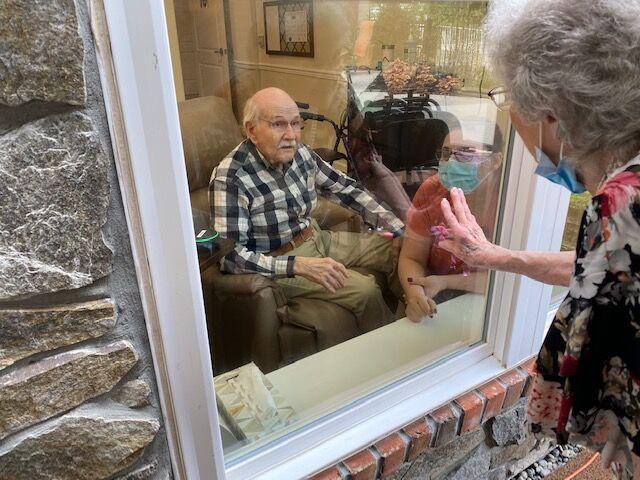For 66 years, Marion and Robert Brubaker have been inseparable, from their 48 years in music ministry at York’s Zion United Church of Christ to a post-retirement move to Willow Valley Communities in 2017.
When Robert needed more assistance with everyday activities, he moved into The Glen, the community’s skilled nursing facility. Marion made the trip from their apartment to visit with Robert at least every other day, sharing ice cream or coffee, reminiscing and reminding him to play piano to keep his spirits up and his mind sharp.
Those visits stopped suddenly when COVID-19 forced Willow Valley to restrict visitors from entering its health care unit. Robert, 90, and Marion, 85, were limited to short phone conversation for much of this spring.
But now the Brubakers are seeing each other again once a week, thanks to an innovative approach to in-person visits called Connections Cottages. Quickly built onto the outside of each health care facility at Willow Valley, a cottage allows visitors — physically separated by a window pane — to speak to and see each other in a comfortable, climate-controlled setting.
“The first time, I told him I thought he looked good,” Marion said. “I told him he looked good for 90, and he laughed.”
New ways of visiting are just one of the many adjustments local retirement communities have made as they try to balance health concerns with the social and daily living needs of residents.
Tablets and in-room TVs are offering virtual interactions and entertainment; meal delivery and grocery shopping temporarily replaced dining room options for thousands; and some communities encouraged the expanded use of telemedicine and home health services to reduce trips off campus.
Many of those services are likely to remain long term — most likely supplementing traditional, in-person services — after the threat of COVID-19 abates. In the short term, they may be just what retirement communities need to continue attracting new residents during a time of crisis and uncertainty.
“The pandemic really highlighted why living in a retirement community is an excellent choice for many people,” says Adam Marles, president and CEO of LeadingAge PA, an association representing aging services providers statewide. “Our members reacted swiftly, providing grocery deliveries and enhanced access to technology, screening access to their campuses to mitigate spread, and creating ways to stay connected and engaged even though day-to-day life had to change.”
Entertained by electronics
Before COVID, Masonic Villages in Elizabethtown offered 25-30 trips a month and routinely brought in entertainers while offering a wide variety of educational, spiritual and artistic opportunities for residents.
Since the pandemic started, the community has heavily promoted use of its K4 Village Connect portal to keep residents engaged, according to Mark Eyer, director of retirement living. K4 Connect allows users to easily video call family members from laptops, tablets and mobile phones, and staff can use the portal to share new information including in-room menu options and virtual event listings.
The community adapted its wellness and recreation programming, too. Residents raved about group fitness classes offered over an in-house television station, as well as “brain games” and health challenges organized by staff.
Virtual hosting allows more classes at more times, and residents can “drop in” at the last minute. Classes will double from seven to 16 weekly when in-person activities resume.
At Landis Homes, president Larry Zook set up an Amazon Echo Show to communicate with his mother. He also encouraged social services and pastoral staff to pursue use of iPads and other equipment to keep residents in touch with one another and friends outside the Lititz community.
One resident virtually attended the funeral of the sister she’d lived with her entire life; Another who was dying was able to reconnect with a retired church leader from the country where she’d serve as a missionary “for a very meaningful, sacred time of connection.”
“Prior to the COVID pandemic, we had not made these tools available, though we could have,” Zook wrote in a blog post. “These communication technologies have offered rays of sunshine that will bring joy and serve residents, clients and their families, and team members well for many years to come.”
Health and helpers
At Masonic Homes, staff from the community’s home care division began caring for and interacting with residents whose loved ones were no longer allowed on campus.
“Home care staff have filled in to help with grocery shopping, filling medications and medisets, doing laundry, assisting with transportation to appointments and offering companionship,” says Kathleen Noll, home care manager.
The expectation is that more independent residents will opt for such support even as visitor limitations are eventually relaxed.
“What these circumstances have done is enabled families to see how home care can be extra support to allow people just to enjoy their visits as family members and not as a caregivers,” Noll says.
At times, those in-home staff members became a critical link to outside services. They used smartphones and tablets to enable telehealth visits, becoming an advocate for the resident or a liaison with a medical provider.
According to a 2019 Leading Age report, use of resident engagement and electronic health documentation technologies were becoming commonplace technologies at the nation’s largest not-for-profit senior living facilities. Anecdotally, use of once less-popular remote patient monitoring, communication and telehealth tools have now exploded.
The Centers for Medicare & Medicaid Services also expanded its coverage of telehealth in skilled nursing facilities (and beyond) due to the pandemic, and many retirement communities expect related services will continue post-COVID-19.
Combined, all of those technology changes have been a comfort to seniors who might have felt isolated in a home without them, Marles notes.
“Our members have strong and reliable internet service and staff that can assist as residents learn the new technology,” he says. “Then, through wellness programs, communities can help residents stick to their doctors’ guidance if the individual would like the help. Since it’s so new, not all senior living organizations have begun to use this as an additional selling point, but it is yet another example of how retirement communities make retirement easier for those who decide to make the move.”
Kelly Eakin, director of sales and marketing at Masonic Village, says her community’s resourcefulness reaffirms a commitment to caring.
“We’ve had several residents tell us how relieved they were to be (here) since big decisions were made on their behalf, and they felt more secure than they would have living in their former home,” she says.
Back at Willow Valley, Marion Brubaker is happy to be enjoying socially distanced outings with a few friends in a courtyard near her apartment building. She bakes and cooks meals for herself, relying on groceries now delivered straight to her door. And while she misses live church services and the classical musicians who performed on campus regularly, she says she is happy to live in a place focused on her health and safety.
“I don’t worry down here,” she says. “They really take care of us.”
















